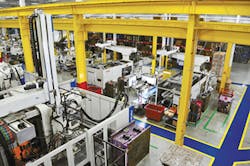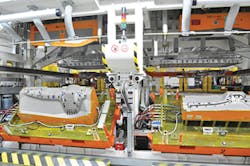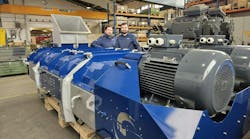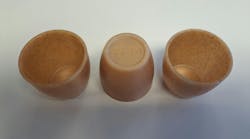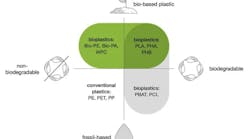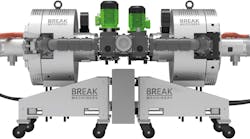The day starts at International Automotive Components' Anniston, Ala., factory with a highly scripted, stand-up meeting in the Team Performance Center. Every key manager in the plant quickly goes through immediate concerns and how his or her department is doing on achieving long-term goals. Walls in the meeting room are covered with status charts — several have been converted to electronic display that show real-time performance — and the meeting involves most of the displays. The 30-minute session finishes with everyone gathered at a giant wall calendar where people have added Post-It notes with questions that need to be answered by a specific day.
When the meeting ends, there is no question where the day or the plant is headed. A similar meeting takes place every morning at each of the 14 injection molding plants in IAC's North American Cockpit and Overhead Group.
READ SIDEBAR: TRAINING INVESTMENT PAY OFF
The entire group has just started the final year of a three-year program to go from being an average automotive Tier 1 injection molding company to an excellent one.
In 2014, group executives conducted an extensive analysis of its manufacturing operations. The deep study determined that IAC — based in Findel, Luxembourg, and one of the world's largest injection molders — was only average in key metrics. IAC's best cycle times were slower than the world-class cycle times of some competitors.
"It was a difficult thing to sit with senior management and say, 'This is who we are,' " said Joel Scott, IAC's senior director of manufacturing operations, based in the company's North American regional headquarters in Southfield, Mich. "Our core assets — high-pressure injection presses — were underutilized … but the plants were asking for more assets to shoehorn in between what they already had."
Several risks were also identified, such as personnel safety, quality, unnecessary costs from a reactive environment that led to increased premium freight expenses and extended downtime, and on-time delivery to customers.
"We determined that by not using our assets properly, we were losing out in operational costs and hurting ourselves in [our] ability to spend money wisely," Scott said during an interview at the Anniston facility. "Our higher costs were driving out our competitive advantage."
About 35 percent of IAC's global sales were tied to its injection molding process. "Our reputation was damaged, and we saw deteriorating performance," Scott said.
An aggressive, three-year strategy was developed that focused on people first, followed by safety, quality, cost and delivery. Revised plans were also put in place for acquiring new equipment, materials and production scheduling, operational technology investments, operational support and training.
The improvement plan defined injection molding excellence as world-class cycle times, regional standard process development, data-driven cost-effectiveness and cost-competitiveness for customers.
So how is it going? The Anniston plant offers some clues.
The Anniston plant, with 36 injection molding machines, 10 door-panel assembly lines, a dual-platen vacuum forming line and extensive foamed-backed carpet manufacturing capabilities, manufactures door panels, instrument panels, vehicle floors, storage boxes and hard trim. Products from Anniston go to 16 different Nissan, Honda, Kia and Mercedes-Benz plants scattered between Iowa City, Iowa, and San Antonio. Sales from the plant are on track to reach $200 million next year.
The 259,000-square-foot building on the site of the former Fort McClellan army post is 65 years old. Inside, it is spotless and well-organized. Injection molding machines, with clamping forces ranging from 50 tons to 3,300 tons, are lined up in the middle of the plant. Each is equipped with a robot and overhead cranes.
Another area is designated for carpet production, which is compression molded, then backed with foam and cut with water jets. There is a vacuum forming line for instrument panels, a welding station and multiple areas devoted to assembly for such items as doors.
The plant runs three shifts, five days a week. There are 423 hourly and 60 salaried employees.
The Anniston plant has 77 active molds and 53 are running at world-class cycle times. During a visit by Plastics Machinery Magazine, a person delivered a report on cycle times while standing beneath a sign that reads, "What Gets Measured Gets Accomplished." At Anniston, as with the other 13 IAC Cockpit Group plants, seemingly everything gets measured.
Groupwide, IAC currently has 421 molds running at best-in-class cycle times and 209 at world-class times. Two years ago, the group had only about 20 molds running at best-in-class times and zero at world-class times.
On the day PMM visited, several Honda employees in their distinctive all-white work uniforms were in the IAC plant inspecting operations. The plant manufactures major assemblies for the Honda Ridgeline truck and is gearing up for two additional big projects for the Honda Odyssey SUV.
Just outside the Team Performance Center, assembly takes place at tables designed in-house to hold everything the technician needs and to prevent damage to parts. Roll-out shelves, power outlets, pegs dipped in plastic, shadow boards for tools, laminated flip-charts to show standards for different components — everything is easily accessible. Nissan gave the plant an award for the tables' design.
A worker at the assembly tables is required to use a floor mat that is color-coded red, yellow, blue or green to identify his or her level of training. The color scheme is continued with workers' badges and vests. A supervisor or senior person in that department can see immediately who might need additional help or supervision.
"There has been a big transformation in this plant during the past two years," Scott said.
"But we still have a lot to do," said Odis De Souza, plant manager for the past two years. De Souza's plant operates with a military-like efficiency.
As of early December, the Anniston plant had received only 19 customer complaints last year.
All 14 plants in the IAC Cockpit Group have benefitted by reducing the number of injection molding machines while maintaining or boosting production capacity. Two years ago, the group had more than 600 presses; at the end of this year, the number will be reduced by 197 presses — nearly one-third less. The Anniston plant will eliminate 10 presses and double its injection molding workloads.
"Prior to 2014, the company bought all different types of presses," Scott said. With 600-plus injection molding machines, efficiency was lost.
In 2015, presses from KraussMaffei, Engel and Milacron were evaluated. IAC engineers and technical teams rated clamping systems, controls, mechanics of the machine itself, service in terms of installation and post-installation, and training available from the machinery makers. The evaluations were given back to the machinery manufacturers so they could develop countermeasures for any points.
"When they came back to us, we were impressed most by KraussMaffei," Scott said. The result is that now IAC purchases only hydraulic KraussMaffei machines for all presses with more than 500 tons of clamping force.
The company conducted a similar evaluation process for small-tonnage presses with KraussMaffei, Engel, Milacron and Toshiba. All-electric Toshibas became the standard.
IAC has also standardized platen size, maximum pressure, barrel sizes and other features for new machines.
Sepro is the choice for robots, Husky for hot runners, Conair for material management. There are also plans to standardize how molds are built.
A walk through the plant finds primary and auxiliary equipment from dozens of manufacturers. Plans call for vacuum forming machines to be standardized next, then all additional auxiliary equipment, using the same procedure as the injection molding machines.
The current tandem vacuum forming machine in Anniston is from Frimo Inc. IAC plans to evaluate Frimo, KraussMaffei and Kiefel vacuum forming equipment.
Every safety critical component and finished good manufactured in Anniston has an electronic birth certificate that describes the process it went through, who touched it, the source of the material used in it and other factors that could impact quality. Approximately 35 percent of the products manufactured at Anniston are door panels, followed by hard trim at 26.6 percent, instrument panels at 18 percent, floors at 15.2 percent and dash instrument panel liners at 5.2 percent. The biggest customers are Nissan at 52.6 percent and Honda at 38.6 percent.
The Anniston plant started manufacturing floor carpet assemblies only a couple of months ago. Carpet arrives in large rolls that are cut into rectangular blanks. The blanks are heated and pressed at about 2,200 pounds per square inch into the shape of the floor. Next, the part goes into a forming die where foam is injected onto the back for padding and sound dampening.
Numerous openings are cut with a four-head robot water jet. Clips to attach the carpet to the floor are added manually and a camera checks that all cutouts are complete. It takes 4-5 minutes to produce one complete carpet assembly. De Souza said the goal is to use the plant's five assembly fixtures to produce seven carpet assemblies every 15 minutes.
IAC is fundamentally changing the way it looks at its injection molding business, Scott said. Some customers have increased their programs with IAC, such as the new Honda project starting at the Anniston plant in 2017.
"We need to be more nimble to compete," Scott said. "We still steer like a battleship. In 4 to 5 years, we want to steer like a fighter jet."
Ron Shinn, editor
Contact:
IAC, 248-455-7000, www.iacgroup.com
